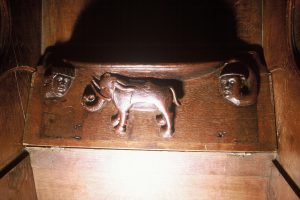 Exeter Cathedral plays a significant role in Plague of a Green Man, the second of my Lady Apollonia West Country Mysteries, set in 1380. The Lady of Aust, my heroine, is given a tour of the cathedral as part of the story. Although they are not mentioned in my story because the Lady would not have been allowed to enter the quire, Exeter’s misericords were present in the quire at that time and had been there for a century or more by 1380. They are excellent examples of wood carving dating back to the period of the Norman cathedral in Exeter. There are fifty misericords, of which 48 date back to the 13th century.
Exeter Cathedral plays a significant role in Plague of a Green Man, the second of my Lady Apollonia West Country Mysteries, set in 1380. The Lady of Aust, my heroine, is given a tour of the cathedral as part of the story. Although they are not mentioned in my story because the Lady would not have been allowed to enter the quire, Exeter’s misericords were present in the quire at that time and had been there for a century or more by 1380. They are excellent examples of wood carving dating back to the period of the Norman cathedral in Exeter. There are fifty misericords, of which 48 date back to the 13th century.
Misericords were a medieval solution to the discomfort that clergy regularly faced when required to stand for long periods of worship. By the 12th century, there were references to such tip-up seats in quires, the jutting upper ledge of which allowed the occupant of the quire stall to rest some of his weight while still nominally standing. The wood carving under the ledge was designed to support that ledge as well as providing carved decoration. The term misericord is derived from the Latin word for compassion or mercy.
The misericords of Exeter are the oldest complete set known in England. They have survived several changes in the stalls of the quire going back to the Norman cathedral. New stalls were built for the Decorated English Gothic church in the late 13th and the 14th centuries but the ancient misericords were reused in them. There were later changes in the quire at the time of the Reformation, at the time of the Commonwealth, and in Victorian times but each time the Norman misericords were reused in the new stalls.
The best-known misericord in Exeter is the carving of an elephant, shown above. It is now displayed in the south quire aisle rather than in its original home in quire stall #44. When this was carved, English people would have known nothing of elephants in their island nation. There was a single elephant at the Tower of London in the 13th century which had been a gift to the king from an alien prince. It is doubtful that the medieval carver who did this misericord had ever seen an elephant. Much of the body resembles a real elephant, but when we look at its feet, it appears to have horses’ hooves. There were drawings of an elephant made by the chronicler, Matthew Paris, circulating in medieval England. It is possible that the carver had seen one of these.
The subjects carved on Exeter’s misericords include persons in various activities, real animals such as the elephant, a lion, a pair of fish or a pair of birds, but also fictitious animals such as mermaids, sirens, dragons, mythical beasts, or centaurs. Some were carved with designs using stiff foliage, at times being spewed out of the mouth of a beast. Unlike other carving of wood and stone in Exeter cathedral, the misericords all are secular and include no religious subjects.
For more on the Exeter misericords, click on
www.misericords.co.uk/exeter.html .
For more on misericords in general, click on
https://en.wikipedia.org/wiki/Misericord .
Tags: Chaucer's England, historical fiction, medieval mysteries